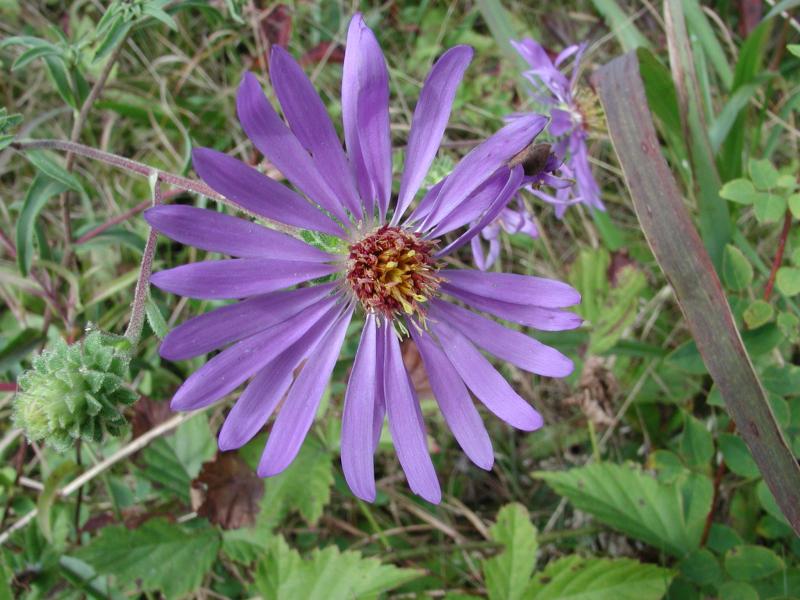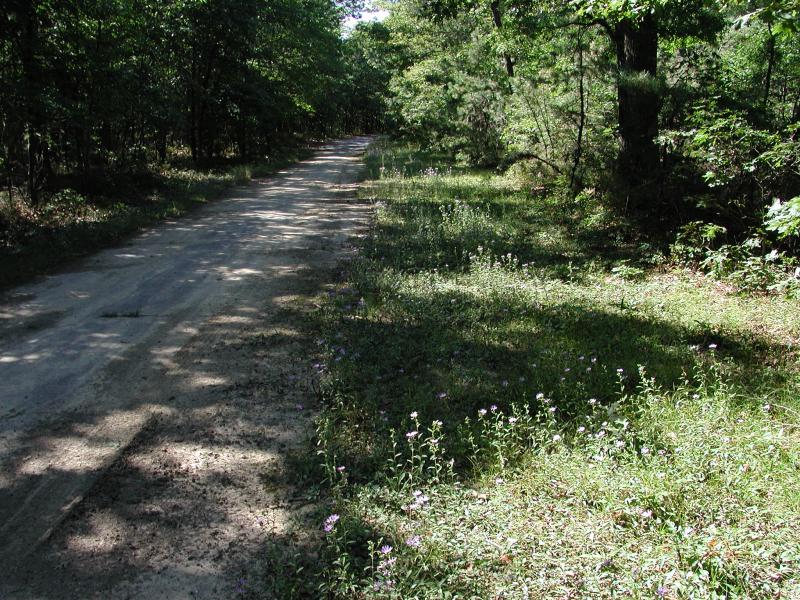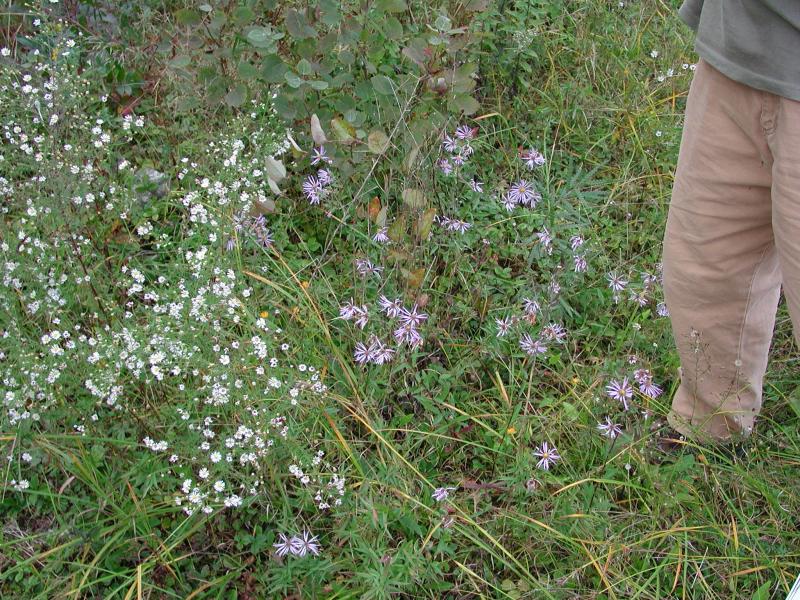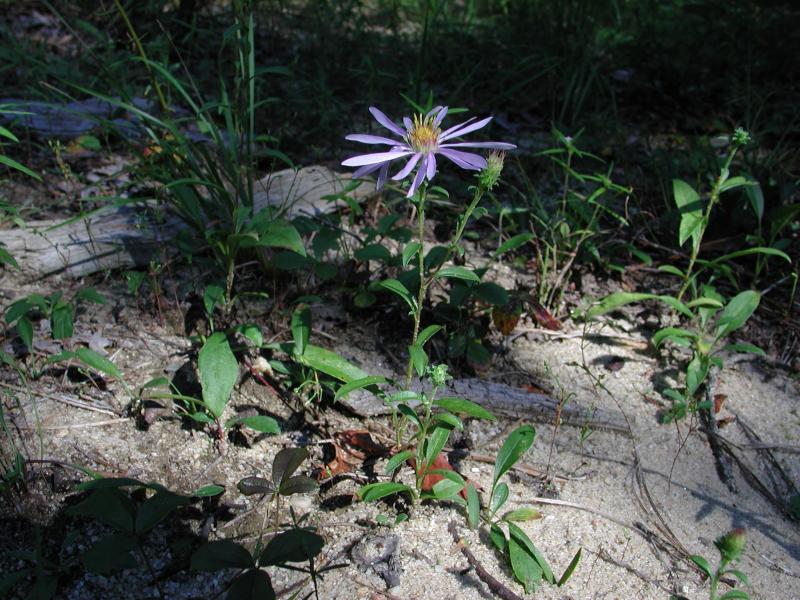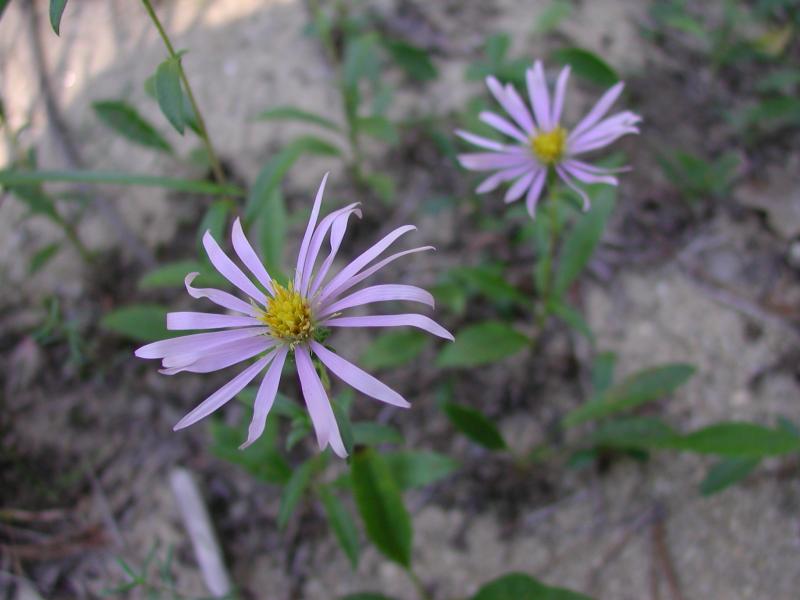Showy Aster
Eurybia spectabilis (Ait.) Nesom
- Class
- Dicotyledoneae (Dicots)
- Family
- Asteraceae (Aster Family)
- State Protection
- Threatened
Listed as Threatened by New York State: likely to become Endangered in the foreseeable future. For animals, taking, importation, transportation, or possession is prohibited, except under license or permit. For plants, removal or damage without the consent of the landowner is prohibited.
- Federal Protection
- Not Listed
- State Conservation Status Rank
- S2
Imperiled in New York - Very vulnerable to disappearing from New York due to rarity or other factors; typically 6 to 20 populations or locations in New York, very few individuals, very restricted range, few remaining acres (or miles of stream), and/or steep declines.
- Global Conservation Status Rank
- G5
Secure globally - Common in the world; widespread and abundant (but may be rare in some parts of its range).
Summary
Did you know?
The genus Eurybia was named after the greek goddess of the mastery of the sea. She presided over the rise of the constellations and their associated weather systems, and the power of the winds. Even though this species is near the sea on Long Island it likes the drier sands of the pine barrens. It is available in the nursery trade but is not planted widely on Long Island. NYNHP only tracks native populations.
State Ranking Justification
There are 15 existing populations and one third of these are in good to excellent condition. The rest of them are under 50 plants each and in small areas that are under threat. There are about 25 historical populations, many of which have not been resurveyed or are considered extirpated.
Short-term Trends
Existing populations that have been resurveyed are stable but about half of them have not been resurveyed and are in small openings that are susceptible to succession or other disturbances.
Long-term Trends
The long-term trend has been negative as many populations have been extirpated by development on Western Long Island and many existing populations are small and threatened.
Conservation and Management
Threats
Improper mowing and maintenance of roadsides and other open habitats where these plants grow is the greatest threat.
Conservation Strategies and Management Practices
Plants need to be protected from direct impact from hikers and mowing equipment. Mowing schedules need to be adjusted to prevent cutting of the plants during flowering and fruiting. The picking of plants along roadsides and trails should also be prevented.
Research Needs
This species only occurs in a small portion of the many open habitats along roads and trails and natural grasslands. Research is needed to understand why more of this habitat is not occupied and if population augmentation would be successful.
Habitat
Habitat
In New York Showy Aster has most often been found in sandy, grassland habitats. Many of the known sites for this plant are within pine barrens habitats, particularly at disturbed sites such as airstrips, railroads, and mowed roadsides. The sole known site from the lower Hudson Valley is on a rocky summit, where it grows with with a mixture of shrubs, grasses, and herbs (New York Natural Heritage Program 2007). Dry, sandy soil, often among pines (Gleason and Cronquist, 1991). Dry sandy open woods and clearings (Fernald, 1970).
Associated Ecological Communities
- Maritime grassland
(guide)
A grassland community that occurs on rolling outwash plains of the glaciated portion of the Atlantic coastal plain, near the ocean and within the influence of offshore winds and salt spray.
- Mowed roadside/pathway
A narrow strip of mowed vegetation along the side of a road, or a mowed pathway through taller vegetation (e.g., meadows, old fields, woodlands, forests), or along utility right-of-way corridors (e.g., power lines, telephone lines, gas pipelines). The vegetation in these mowed strips and paths may be dominated by grasses, sedges, and rushes; or it may be dominated by forbs, vines, and low shrubs that can tolerate infrequent mowing.
- Pitch pine-heath barrens*
(guide)
A shrub-savanna community that occurs on well-drained, sandy or rocky soils. The most abundant tree is pitch pine and the shrublayer is dominated by heath shrubs.
- Pitch pine-scrub oak barrens
(guide)
A shrub-savanna community that occurs on well-drained, sandy soils that have developed on sand dunes, glacial till, and outwash plains.
- Railroad
A permanent road having a line of steel rails fixed to wood ties and laid on a gravel roadbed that provides a track for cars or equipment drawn by locomotives or propelled by self-contained motors. There may be sparse vegetation rooted in the gravel substrate. The railroad right of way may be maintained by mowing or herbicide spraying.
- Rocky summit grassland
(guide)
A grassland community that occurs on rocky summits and exposed rocky slopes of hills. Woody plants are sparse and may be scattered near the margin of the community. Small trees and shrubs may be present at low percent cover.
* probable association but not confirmed.
Associated Species
- Agalinis setacea (needle-leaved agalinis)
- Aletris farinosa (white colicroot, unicorn-root)
- Andropogon virginicus
- Baptisia tinctoria (wild-indigo)
- Betula lenta (black birch)
- Carex pensylvanica (Pennsylvania sedge)
- Chrysopsis mariana (Maryland golden-aster)
- Comptonia peregrina (sweet-fern)
- Danthonia spicata (poverty grass)
- Deschampsia flexuosa
- Eupatorium hyssopifolium (hyssop-leaved thoroughwort)
- Festuca ovina
- Gaylussacia baccata (black huckleberry)
- Hypericum gentianoides (orange-grass)
- Hypoxis hirsuta (yellow star-grass)
- Lechea minor (thyme-leaved pinweed)
- Liatris aspera (rough blazing-star)
- Linum intercursum (sandplain wild flax, Bicknell's yellow flax)
- Pinus rigida (pitch pine)
- Polytrichum
- Prunus serotina
- Pteridium aquilinum
- Quercus ilicifolia (scrub oak, bear oak)
- Quercus montana (chestnut oak)
- Quercus rubra (northern red oak)
- Rubus flagellaris (northern dewberry)
- Schizachyrium scoparium
- Sericocarpus linifolius (narrow-leaved white-topped-aster)
- Solidago juncea (early goldenrod)
- Solidago nemoralis
- Solidago puberula (downy goldenrod)
- Sorghastrum nutans (Indian grass)
- Spiranthes tuberosa (little ladies'-tresses)
- Symphyotrichum lateriflorum (calico-aster)
- Vaccinium angustifolium (common lowbush blueberry)
- Vaccinium pallidum (hillside blueberry)
- Viola novae-angliae (New England violet)
Range
New York State Distribution
In New York nearly all records of Showy Aster are from Eastern Long Island, except for a single extant population known from the Hudson Highlands in Orange County.
Global Distribution
Showy Aster reaches the northern edge of its range in New York and Massachusetts, and is found south, chiefly (though not solely) along the coast, to Georgia and Alabama. It is of conservation concern in much of its range.
Identification Comments
General Description
Showy aster is a tall (up to 90 cm), perennial herb, spreading and forming clones by underground stems (rhizomes). The stem is covered with dense, glandular hairs. Most of the leaves are basal, usually with rough hairs, especially on the underside, and the blades (which are lance-shaped to egg-shaped) taper to the petiole. The infloresences contain from few to many (35 or more) heads. These are compound, with 15 to 35 violet-purple ray flowers (petal-like and 1-2.5 cm long) surrounding a center of yellow disc flowers. The involucre (the structure of densely-packed bracts which forms the base of the flower head) have green, spreading tips.
Best Life Stage for Proper Identification
Flowering specimens are necessary for identification.
Similar Species
Among asters, the genus Eurybia may be identified by its cordate leaves and disk flowers with long tubes and short, bell-shaped corollas (FNA 2006). The large, purple ray flowers and spreading involcrual bracts are distinctive among New York Eurybia. Eurybia x herveyi (a hybrid which of which E. spectabilis is one of the parents) has lower leaves that abuptly contract to a petiole, toothed stem leaves, and involucral bracts that are appressed, rather than spreading as are those of E. spectabilis, and generally shorter ray corollas.
Best Time to See
Showy Aster flowers early August into the fall.
- Flowering
- Fruiting
The time of year you would expect to find Showy Aster flowering and fruiting in New York.
Showy Aster Images
Taxonomy
Showy Aster
Eurybia spectabilis (Ait.) Nesom
- Kingdom Plantae
- Phylum Anthophyta
- Class Dicotyledoneae
(Dicots)
- Order Asterales
- Family Asteraceae (Aster Family)
- Order Asterales
- Class Dicotyledoneae
(Dicots)
- Phylum Anthophyta
Synonyms
- Aster commixtus (Nees) Kuntze
- Aster smallii Alexander
- Aster spectabilis var. cinerascens Blake
- Aster spectabilis var. spectabilis
- Eurybia commixta Nees
Comments on the Classification
Hybrids between Aster spectabilis and Aster macrophyllus have been called Aster herveyi.
Additional Resources
Best Identification Reference
Flora of North America Editorial Committee. 2006. Flora of North America North of Mexico. Vol. 20. Magnoliophyta: Asteridae, Part 7: Asteraceae, part 2. Oxford Univ. Press, New York. xxii + 666 pp.
Other References
Clemants, Steven and Carol Gracie. 2006. Wildflowers in the Field and Forest. A Field Guide to the Northeastern United States. Oxford University Press, New York, NY. 445 pp.
Fernald, M.L. 1950. Gray's manual of botany. 8th edition. D. Van Nostrand, New York. 1632 pp.
Gleason, Henry A. and A. Cronquist. 1991. Manual of Vascular Plants of Northeastern United States and Adjacent Canada. The New York Botanical Garden, Bronx, New York. 910 pp.
Holmgren, Noel. 1998. The Illustrated Companion to Gleason and Cronquist's Manual. Illustrations of the Vascular Plants of Northeastern United States and Adjacent Canada. The New York Botanical Garden, Bronx, New York.
New York Natural Heritage Program. 2010. Biotics database. New York Natural Heritage Program. New York State Department of Environmental Conservation. Albany, NY.
New York Natural Heritage Program. 2024. New York Natural Heritage Program Databases. Albany, NY.
Newcomb, Lawrence. 1977. Newcomb's Wildflower Guide: An Ingenious New Key System for Quick, Positive Field Identification of the Wildflowers, Flowering Shrubs, and Vines of Northeastern and North-Central North America. Little, Brown and Company. Boston.
Rhoads, Ann F. and Timothy A. Block. 2000. The Plants of Pennsylvania, an Illustrated Manual. University of Pennsylvania Press, Philadelphia, PA.
Weldy, T. and D. Werier. 2010. New York flora atlas. [S.M. Landry, K.N. Campbell, and L.D. Mabe (original application development), Florida Center for Community Design and Research http://www.fccdr.usf.edu/. University of South Florida http://www.usf.edu/]. New York Flora Association http://newyork.plantatlas.usf.edu/, Albany, New York
Weldy, Troy W. and David Werier. 2005. New York Flora Atlas. [S.M. Landry, K.N. Campbell, and L.D. Mabe (original application development), Florida Center for Community Design and Research. University of South Florida]. New York Flora Association, Albany, NY. Available on the web at (http://newyork.plantatlas.usf.edu/).
Links
About This Guide
Information for this guide was last updated on: January 18, 2008
Please cite this page as:
New York Natural Heritage Program. 2024.
Online Conservation Guide for
Eurybia spectabilis.
Available from: https://guides.nynhp.org/showy-aster/.
Accessed July 27, 2024.
